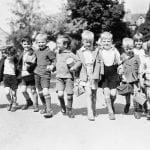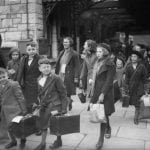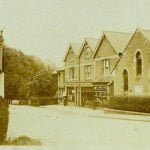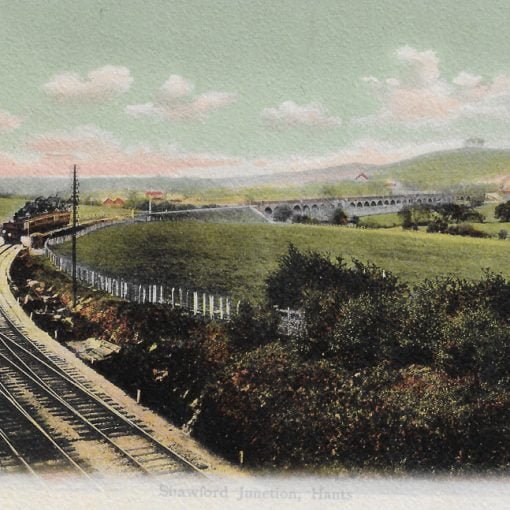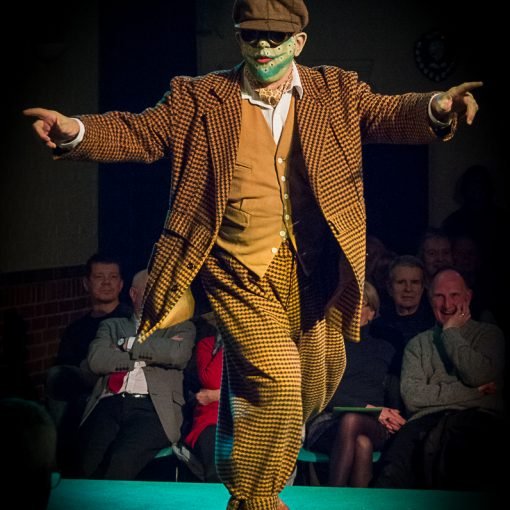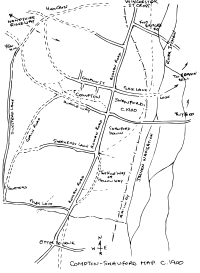MEMORIES OF AN EVACUEE
by Colin Hayden
- London Evacuees out and About in Reading, Berkshire, England, 1940 (D 824) A group of smiling evacuees with gas mask boxes hold hands on a walk in Reading. These boys and girls were originally from the Galleywall Road area of Rotherhithe in Kent. Copyright: © IWM. Original Source: http://www.iwm.org.uk/collections/item/object/205125862
- Evacuees from Bristol to Kingsbridge, Devon, 1940 (D 2593) A group of evacuees from Bristol carry bags, suitcases and gas masks as they walk off the platform upon arrival at Brent station. About 175 children were evacuated at this time from Bristol to the Kingsbridge area of Devon. Copyright: © IWM. Original Source: http://www.iwm.org.uk/collections/item/object/205195806
- Vintage postcard of Shawford showing the Mission Hall, presumably where Colin and the other evacuees were allocated their hosts. Hampshire Records Office 191A09/A12-10
(Jean Millar has supplied this absorbing account of a wartime evacuee to Shawford)
I first saw Shawford at lunchtime on September 1st 1939. Yes .. I was an evacuee, one of the millions of children who were on the move that day. It was to have been my first day at Langstone Junior School, Portsmouth, but it became a day I’ll always remember.
After saying goodbye to my parents we were taken by bus to the main railway station in Portsmouth, given an apple, a bar of chocolate and a label (which carried our name and address). Then with our gas masks and a small case we were soon on the train to … who knew where? After some time, apple and chocolate long gone, we arrived at the small country station (it was small – it was not enlarged until 1941) of Shawford. Then in the local baptist chapel we were split into groups and set off in different directions. I was in a group that trudged up the hill, across the golf course to a large house in Southdown Road. Again separated by the WVF, brothers and sisters where possible were billeted together. I ended up with another lad called John Spanton and a young female teacher; we were billeted in The Tiled House, Southdown Road. To a 7 year-old this was a huge house with a vast garden, after my modest home in Portsmouth.
The lady to whom the house belonged was Miss Ruth Preston Joy. She had a butler, a cook, two maids and in the adjacent smaller house lived the chauffeur and his family. I suppose there must have been a gardener too. The cook was in charge of us – a formidable lady – and naturally it was a case of “above stairs” and “below stairs”. Looking back I felt like one of the characters out of a Charles Dickens novel. I was nearly 7 years and 8 months old.
Our schooling was carried out in a haphazard fashion in Shawford Village Hall. Two things I remember especially about the hall was the 1st World War field gun standing by the entrance gate – a marvellous plaything for us boys with all the ever present war hysteria, and the other was the order that in the event of air raids we were to run with our gas masks to the foot of the down and take cover in a golf bunker. After a few weeks my chum, John, ran away and made his way home to Portsmouth – not bad for a 7 year-old. The teacher also left for some reason or other and thus I continued on my own for a few months.
It must be noted that no bombing took place and that most of the children gravitated back to Portsmouth. I think I then started at Compton Church of England School and to be nearer this school I left the Tiled House and moved to a cottage with two other lads (David Hobbs and Ronnie Hunt). It was the home or Mr and Mrs Holloway and is now called Parsonage Cottage. This was heaven – a large barn next door to explore and plenty of fields to roam about. The cottage, however, had neither electricity nor a bathroom.
Lighting was with gas and candle and being the youngest in the household my job once a week was to walk down Compton Street to the big farm across the main road and collect the charged accumulator to run the wireless! Bathtime was in a galvanised tin bath in an attached lean-to shed, hot water being provided by a wood-burning copper.
Life continued for three years at Compton with Mrs and Mrs Holloway (incidentally Mr Holloway was an ARP warden at Eastleigh), enlivened by the occasional incendiary bomb, collecting cartridges from aerial day fights during the Battle of Britain and so on. Highlights in the rural scene were sheep shearing in the nearby barn, mouse hunting when wheat ricks were threshed, potato picking and some very cold winters. Every Sunday there was Sunday School in the afternoon and services with the church choir, matins and evensong. In 1943 I passed the scholarship, left Compton and went to Winchester with the Portsmouth Northern Secondary School, so I was still evacuated, only returning home at Christmas 1944 after the threat of V1 bombs was finally over.
I have many happy memories, although at the time I wondered when I was ever going home. Some mementoes include a bible given to me on my 8th birthday by Miss Ruth. For some years after I exchanged Christmas cards with Mrs Holloway.
COLIN HAYDEN
Reprinted from the Compton & Shawford Parish Magazine, November 1999
We have no photographs of Colin Hayden or evacuee children in Shawford.
So this article is illustrated by generic photographs of evacuee children from the Imperial War Museum archive.

